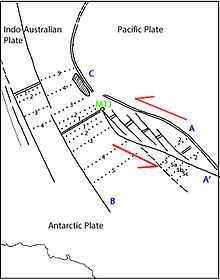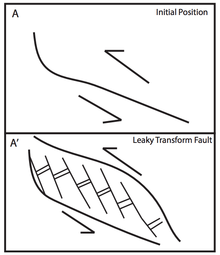Macquarie Triple Junction

The Macquarie Triple Junction is a geologically active tectonic boundary located at 61°30′S 161°0′E / 61.500°S 161.000°ECoordinates: 61°30′S 161°0′E / 61.500°S 161.000°E[1] at which the Indo-Australian Plate, Pacific Plate, and Antarctic Plate collide and interact. The term Triple Junction is given to particular tectonic boundaries at which three separate tectonic plates meet at a specific, singular location. The Macquarie Triple Junction is located on the seafloor of the southern region of the Pacific Ocean, just south of New Zealand. This tectonic boundary was named in respect to the nearby Macquarie Island, which located southeast of New Zealand.
Evolution, stability, and migration
Our understanding of the evolution of the Macquarie Triple Junction was made possible due to extensive research of the regions tectonic magnetic anomalies as well as local fractures reconstruction. The origin of the Macquarie Triple Junction has been interpreted to have occurred 47.91 Mya (million years ago), based on Anomaly 21.[2] Thorough reconstruction of the Macquarie Triple Junction begins at 33.3 Mya, in respect to Anomaly 13o, and can be simply described as a southeastward migration of approximately 1100 km in respect to the Australian Plate.[3] The total migration was largely driven by the Australian–Pacific transform boundary.
At 33.3 Mya, the Macquarie Triple Junction was a stable ridge–transform fault–transform fault triple junction. In reference to the Australian Plate, the triple junction moved southeast at an angle of 120° at an approximate rate of 40 km/million years.[3] This trajectory remain relatively constant throughout the Oligocene from 33.3 to 20.1 Mya. During this period of time the Australian-Pacific boundary underwent a transformation from mid-ocean ridge to a strike-slip fault and lastly at 20.1 Mya to a transpression convergent boundary.[3]
Then 10.9 Mya, the Macquarie Triple Junction evolved into a ridge-trench-fault triple junction due to the alteration of the Australian–Pacific Boundary motion. This oblique convergent boundary instigated a clockwise rotation of the Macquarie Ridge Complex forming the Hjord Trench and numerous fracture zones around the Macquarie Ridge Complex.[4] This rotation also transpired into the Macquarie Triple Junction changing its migration path to an angle of 150° and rate of 34 km/million years in reference to the Australian Plate, making the migration direction southward.
Between 5.9 and 2.6 Mya, the Macquarie Triple Junction evolved back into a Ridge–Transform Fault–Transform Fault triple junction as the convergence at the Hjort Trench diminished and Antarctic–Pacific spreading boundary changed back into a transform fault.[3] This is the current state of the Macquarie Triple Junction and is interpreted as a stable ridge–fault–fault triple junction.
Local tectonics


Emerald Fracture Zone
The Emerald Fracture Zone is the westernmost portion of the Pacific-Antarctic Ridge and is a young leaky transform fault zone no older than 2.197-2.229 Ma. This zone was formed during a change in the Pacific-Antarctic Plate Boundary between 3.4 and 3.86 Ma[5] during a transformation of the Pacific-Antarctic Plate Boundary. This transformation was due to the change in the absolute motion of the Pacific Plate in response to Louisville hotspot activity. The alteration of the Pacific Plate ‘s motion caused a left-lateral strike-slip fault to form at the Pacific-Antarctic Boundary. This strike-slip fault is located near the triple junction along a sharp bend in the western most region of the Pacific-Antarctic Boundary. This sharp bend is now the locality of the Emerald Fracture Zone formed from a release bend configuration as seen in transtension.
Southeast Indian Ridge
The Southeast Indian Ridge is the divergent boundary that separates the Indo-Australian and Antarctic Plates. This boundary has experienced a vast right-lateral transform fault called the Balleny Fault Zone, which is also thought to be caused in response to the formation of the Emerald Fracture Zone.[3] This large offset in the Southeast Indian Ridge is thought to have produced a significant difference in crustal thickness within the Australian Plate influencing the Hjort Trench formation.
Hjort Trench
The Hjort Trench is the southernmost portion of the Macquarie Ridge Complex and has been identified as an oceanic-oceanic subduction zone. This trench is found in a region of diagonal convergence produced by the transform fault evolution of the Emerald Fracture Zone.[3] Due to these transpressive plate movements this trench has frequent seismicity events generally less than 20 km depth,[4] which suggest underthrusting of the Indo-Australian Plate underneath the Pacific Plate. This region of underthrusting may eventually evolve into a self-sustaining subduction zone, though the Hjort Trench is thought to be an example of an oceanic subduction zone initiated in response to transform fault development.[6]
Studies of the Macquarie Triple Junction
The understanding Macquarie Triple Junction is primarily known due to of studying of seismicity, gravitational, magnetic and bathymetric data of the region. Initial studies took place during the early 1970s by the Eltanin Cruises, which took bathymetric and magnetic tracks in order to interpret the general sea floor topography and sea-floor spreading rates. Additional surveys have been taken during 1988–1991 by multiple cruises of the OGS-Explora. Theses surveys consist of approximately 6300 km the regions seismicity, gravitational signatures, and additional magnetic and bathymetric surveys, significantly contributing to the understanding of the Macquarie Triple Junction.[4] From analysis of the data obtained from the OGS-Explora, a major change in the Pacific-Antarctic plate motion has been interpreted, instigating the compressional region of the Macquarie Ridge.
Overview of relevant plate boundaries
Indo-Australian Plate and Antarctic Plate boundary
The Indo-Australian Plate and Antarctic Plate Boundary is an active divergent boundary known as the Southeast Indian Ridge. The Southeast Indian Ridge ranges approximately 2000 kilometers across the southern region of the Indian Ocean. The Southeast Indian Ridge has a complex driving force which is due to the interaction of the Amsterdamn-St. Paul Plateau, a developed hot spot in the western portion of the Southeast Indian Ridge, and the mid-oceanic ridge (MOR).[7] The Amsterdamn-St. Paul Plateau along with the Southeast Indian Ridge produce new oceanic crust further separating the Indo-Australian and Antarctic plates at an intermediate tectonic rate of 65 mm/yr.[8]
Pacific Plate and Antarctic Plate boundary
The Pacific-Antarctic Plate Boundary is another active divergent boundary known as the Pacific-Antarctic Ridge(PAR). The Pacific-Antarctic Ridge is the southwest region of the East Pacific Rise, the mid-oceanic ridge located at the base of the Pacific Ocean. The PAR is divergent boundary[9] driven by the interaction of a MOR and deep mantle plumes[10] located in the eastern portion of the East Pacific Rise. Theses deep mantle plumes however, have given the Pacific Plate a left lateral force vector creating a transform boundary in the western Pacific-Antarctic Plate Boundary in the vicinity of the Macquarie Triple Junction, forming the Emerald Fracture Zone.
Indo-Australian Plate and Pacific Plate boundary
The Indo-Australian Plate and Pacific Plate boundary is the most complex boundary of the Macquarie Triple Junction region, due to the unique collision of the two plates creating two convergent boundaries separated by a transform boundary. The Puysequr Trench, which includes the Fjord Trench, is the southern region of the boundary closest to the Macquarie Triple Junction. The Puysequr Trench formed as the Indo-Australian Plate subducted beneath the Pacific plate. The Puysequr Trench ranges approximately 800 kilometers in length, from the most southern tip of the New Zealand Islands to the Macquarie Triple Junction. The Puysequre Trench makes contact with the Macquarie Fault Zone, which is associated with the Alpine Fault. The Alpine Fault is the right-lateral transform fault boundary separating the Puysequr Trench and the northern Kermadec Trench.[11] The Alpine Fault runs through the majority of the southern island of New Zealand and is associated with New Zealand's frequent and intense earthquake history. The last major region of the Indo-Australian Plate and Pacific Plate Boundary is the Kermadec-Tonga subduction zone at which the Pacific Plate is subducted beneath the Indo-Australian Plate, in opposition of the Puysequr Trench. This convergent boundary has a rate of subduction of approximately 5.5-7.4 cm/yr.[11]
References
- ↑ Falconer, R. K. H. (1972). "The Indian-Antarctic-Pacific triple junction". Earth and Planetary Science Letters 17 (1): 151–158. Bibcode:1972E&PSL..17..151F. doi:10.1016/0012-821X(72)90270-1.
- ↑ Marks (1997). "Early Tertiary gravity field reconstructions of the Southwest pacific." (Earth and Planetary Science Leters). pp. 152: 267–274.
- ↑ 3.0 3.1 3.2 3.3 3.4 3.5 Meckel (2003). "Tectonics of the Hjort region of the Macquarie Ridge Complex, southernmost Australian-Pacific Plate Boundary, southwest Pacific Ocean". p. 206. Bibcode:2003PhDT.......206M.
- ↑ 4.0 4.1 4.2 Lodolo, E. and F. Coren (1994). "The Westernmost Pacific Antarctic plate boundary in the vicinity of the Macquarie triple junction." (In C.A. Ricci, ed. Terra Antarctica, vol.1). pp. 158–161
- ↑ Harbert W. &Cox A. (1989). "Late Neogene motion of the Pacific Plate" 94 (J. Geophysical Research). pp. 3052–3064.
- ↑ Garcia-Castellanos, D., M. Torné, and M. Fernàndez (2000). ". Slab pull effects from a flexural analysis of the Tonga and Kermadec Trenches". Geophys. J. Int 141: 479–485. doi:10.1046/j.1365-246x.2000.00096.x.
- ↑ Daniel S. Scheirer, Donald W. Forsyth, and Jaes A. Conder (2012). "Anomalous Seafloor Spreading of the Southeast Indian Ridge near the Amsterdamn-St. Paul Plateau". Journal of Geophysical Research: Solid Earth.
- ↑ Weissel, J. K., Hayes, D. E., & Herron, E. M. (1977). "Plate tectonics synthesis: the displacements between Australia, New Zealand, and Antarctica since the Late Cretaceous". Marine Geology 25: 231–277. doi:10.1016/0025-3227(77)90054-8.
- ↑ Georgen, J.E., Jennifer E. (2014). "Interaction of a mantle plume and a segmented mid-ocean ridge; results from numerical modeling". Earth and Planetary Science Letters 392: 113–120. Bibcode:2014E&PSL.392..113G. doi:10.1016/j.epsl.2014.01.035.
- ↑ Roger Hekinian, Peter Stoffer, and Dietrich Ackerman (1999). "Ridge-hotspot Interaction: the Pacific-Antarctic Ridge and the Foundation Seamounts" (University of Kiel, Geologist–Paleontologist Institution, Germany).
- ↑ 11.0 11.1 Beavan, J. & Haines, J., John; Haines, John (2001). "Contemporary horizontal velocity and strain rate fields of the Pacific‐Australian plate boundary zone through New Zealand". Journal of Geophysical Research: Solid Earth 106b: 741–770. Bibcode:2001JGR...106..741B. doi:10.1029/2000JB900302.